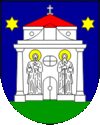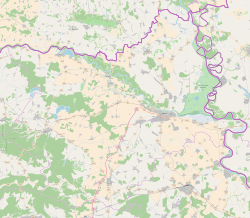Đakovo
| Đakovo | ||
|---|---|---|
| Town | ||
| Town of Đakovo Grad Đakovo |
||

|
||
|
||
| Location of Đakovo in Croatia | ||
| Coordinates: 45°19′N 18°25′E / 45.31°N 18.41°E | ||
| Country |
|
|
| County |
|
|
| Government | ||
| • Mayor | Zoran Vinković (HDSSB) | |
| Area | ||
| • Town | 170 km2 (70 sq mi) | |
| Elevation | 111 m (364 ft) | |
| Population (2011) | ||
| • Town | 27,745 | |
| • Density | 160/km2 (420/sq mi) | |
| • Urban | 19,491 | |
| Time zone | CET (UTC+1) | |
| • Summer (DST) | CEST (UTC+2) | |
| Postal code | 31400 | |
| Area code | +385 31 | |
| Vehicle registration | DJ | |
| Arable land area | 13,505 ha | |
| Forested land area | 2,044 ha | |
| Website | http://www.djakovo.hr | |
Đakovo (Hungarian: Diakovár, German: Djakowar) is a town in the region of Slavonia, Croatia. Đakovo is the centre of the fertile and rich Đakovo region (Croatian: Đakovština [d͡ʑakǒːʋʃtina]).
The etymology of the name is the Greek: διάκος (diákos) in Slavic form đak (pupil). The Hungarian diák word has the same Greek origin and as such it's uncertain the name came directly from Greek or via Hungarian or local Slavic form.
In Roman antiquity the settlement Certissa stood on the same spot until it disappeared during the Migration Period.
The settlement's first mention in historical documents dates from 1239 when Béla IV of Hungary granted it to the Diocese of Bosnia (Latin: Dioecesis Bosniensis), and the Bishop moved his seat here in 1246. The predecessor to the newer St. Peter's Cathedral was built in 1355. In 1374 the settlement is documented under the name Dyacou. Croatian rebels in 1386 on July 25 captured Queen Mary of Hungary and her mother Elizabeth near the settlement.
The Ottoman rule over Đakovo started in 1536 and lasted for nearly 150 years. It was a kaza administrative center in Sanjak of Pojega and was known as "Yakova" during this period. In 1805 a Lipizzan horse herd was evacuated to Đakovo when Napoleon invaded Austria & Hungary and a part of the herd remained permanently here. In a 1910 census the settlement's total population of 6304 were made of 4894 Croatians, 890 Germans, 249 Hungarians and 164 Serbians. In the late 19th and early 20th century the settlement was a district capital in the Virovitica County of the Kingdom of Croatia-Slavonia within the Lands of the Crown of Saint Stephen.
...
Wikipedia



